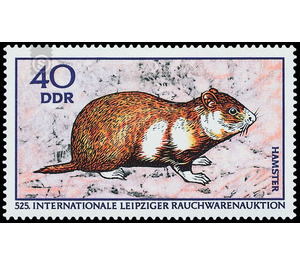525th International Leipzig Smoked Goods Auction - Germany / German Democratic Republic 1970 - 40 Pfennig
Theme: Animals
| Country | Germany / German Democratic Republic |
| Issue Date | 1970 |
| Face Value | 40.00 |
| Color | brown |
| Perforation | K 14 |
| Printing Type | Rotogravure 2 |
| Stamp Type | Postage stamp |
| Item Type | Stamp |
| Chronological Issue Number | 1286 |
| Chronological Chapter | GER-DDR |
| Michel ID | DDR 1544 |
| SID | 281731 |
| In 25 Wishlists | |
For the 525th International Leipzig Smoke Auction Auction At the 525th International Leipzig Smoke Auction Auction, the Ministry of Posts and Telecommunications of the German Democratic Republic issues four multicolored special postage stamps depicting fur animals. The fur trade around Leipziger Brühl In the trade fair city of Leipzig, which is over 800 years old, the trade in fells has a permanent place. The processing of raw fur remained in the hand of the furrier for centuries until the finished garment. In the course of time, since the 16th century, only finishing was practiced, while dressing, dyeing and the actual smoking trade, which concentrated on and around the Leipzig Bruehl, developed into independent, flourishing economic sectors. Since about 1864, for example, about 80 percent of the Russian-Siberian pelts have been traded at the Leipzig fairs. In the second half of the 19th century Leipzig developed into the most important international fur trading center in the world and thus also to the "city of furs". After the First World War, the Leipzig Bruehl experienced a new heyday, on the one hand because of its unrivaled finishing industry and on the other hand with the help of the young Soviet Union, which auctioned off its rich fur population in Leipzig three times a year from 1920 for ten years. The decades-long tradition of international Leipzig tobacco productions continued with the 506th auction in 1960. Now, two international tobacco auctions take place each spring, which are visited every year by smoker traders from almost all European countries as well as from countries of the Orient, India, Japan, Canada and the USA. In addition to the representative Interpelz-Haus am Brühl, which was built in 1965, the new auction building "Brühlzentrum" was also built, where around 1 million raw hides are auctioned off at the annual spring auctions in February and April. In the period from 7 to 12 February 1970 pending 525th and in the period from 4 to 10 April 1970 provided 526th International Leipzig tobacco auction, the following types of fur will be auctioned: location and mutation, including GDR top products with the quality designation "brühlselected", Blue-Red-Korsak- and Silverfoxes, Karakulfelle, Wildcats, Stone- and Pine Marten, Susliki, Burunduki, Feh, Marbles, Polecats, Badgers, Otters, Wolves, Dogs, Foals, Afghan Persians, Fever and marble tails, leopards, tigers, irises, lynxes, rabbits, rabbits and more. a. m. For the trade in tobacco products at the Leipziger Bruehl are especially special fur types Fox, Marten, Hamster and Kanin. The hamster 40 Pfennig value The more important for the trade deliveries come mostly from the area of the GDR, the Soviet Union and Romania. The circulation area is Europe -Asien. The hamster is an animal of the cultural steppe, inhabits especially pronounced areas of grain, and pays particular attention to sandy loam and clay soils, which allow easy digging, but at the same time also give reasonably firm, collapse-proof burrows. Up to 30 kg and more cereals have been found in its construction, so that the hamster is rightly regarded as a major pest of agriculture. In the trade with hamster skins, the GDR occupies a leading position in the world. Many millions of raw skins so run their course through auction auctions on the smokers' wholesaling for refinement until they finally take the actual form and shape of the furrier and in the fur manufacturing industry as fashionable, warming and decorative fur clothing.
| Condition | Name | In Stock | Price | Price + Shipping | Store | |
|---|---|---|---|---|---|---|
 | Unmounted Mint ** | 525th International Leipzig Smoked Goods Auction - Germany / German Democratic Republic 1970 - 40 Pfennig | 1 | US $0.151 | US $7.69 |  willcolector (0) willcolector (0)Shipping US $7.53 |
 | Used | 525th International Leipzig Smoked Goods Auction - Germany / German Democratic Republic 1970 - 40 Pfennig | 1 | US $0.151 | US $7.69 |  willcolector (0) willcolector (0)Shipping US $7.53 |


